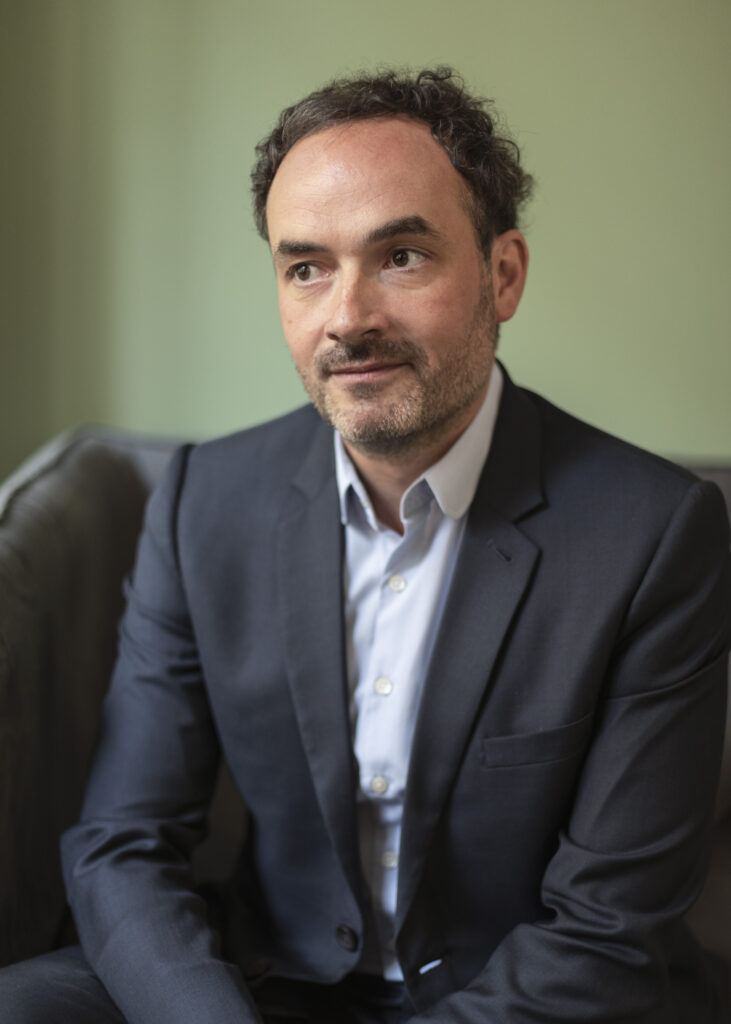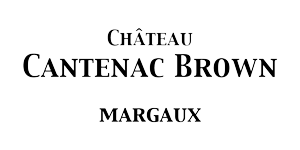The Le Lous family is the new owner of Château Cantenac Brown. For this occasion, we would like to take a look back at the major steps in Tristan Le Lous’ career, his love for wine and for the Bordeaux region. The acquisition of the Château is a childhood dream come true for Tristan and his family who now put all their energy into the service of this grand cru from 1855.
Can you start by introducing yourself?
I’m Tristan Le Lous; I’m 40 years old. I studied agronomy in my youth, and I have always been passionate by wine. It is mostly a family transmission through my grandfather and my father. With my family, I bought a grand cru classé in Margaux called Cantenac Brown. Since then, I have devoted a lot of time and energy to it.
Can you tell us a little more about this passion for wine?
My family initially settled in Burgundy. My grandfather settled there in the 1940’s, originally from Brittany. When he was demobilised, he found himself unemployed because he was a colonel pharmacist in the French army. Through an acquaintance of my grandmother’s, he was offered to take over a failing pharmacy in Dijon. He needed money and found some from the winegrowers in the region. We then found ourselves rubbing shoulders with many winegrowers who had financed my grandfather’s business and remained shareholders in the company for a long time as they stayed until 2005. My grandfather had the opportunity to collect some bottles and to have an exceptional cellar.

Since you were a child, these are things that you see?
In the beginning, I had a beautiful vision of the Burgundy vineyard. We drank from my grandfather’s cellar, even when I was relatively young. When I was 12, 13, 14, we drank wine and, above all, we talked about it. We spent a lot of time at the table talking about the wine we drank.
Was it the wine that made you want to study agronomy?
No, I don’t think so. Traditionally, in the family, you had to study science and then business, which I did. I did Normale Sup in Lyon in molecular genetics, and I wanted to devote myself to research. I realized, through an internship, that this was not what I wanted to do. This job didn’t correspond to the image I had of it during my studies. So I tried to reconvert myself, and the agronomy school was perfect for that. I now realize that 15 years after these studies, I use what I’ve learned almost every day. After doing AgroParisTech, I passed competitive exams, and I found myself admitted to the ESCP.
How is the beginning of your professional career going?
It wasn’t related to wine. My father immediately offered me to join him and my brother in our pharmacy business, which is the legacy left by my grandfather. I’m in charge of finance in this group, which is called URGO. Until last year my professional career had nothing in common with the world of wine.
How have you learned about Bordeaux and its wines?
It came relatively late since it was when I met my wife, who was studying at the Bordeaux Magistrates’ School. I came to see her on weekends, and that’s how I discovered this city, its wines, and the region. When I visited her, we would take a car and go for a walk in the vineyard. I liked it immediately and very much. So, I don’t know if it’s due to meeting my wife or to the context. Since then, I no longer spend my vacations in Bretagne but Bordeaux on the Atlantic coast. I have developed a solid attachment to this region and its wines.
The funny thing is that when I met my wife, I was mostly used to Burgundy wines, and she mainly favored Pessac-Leognan. In the end, it was a cross discovery. Today, I prefer Bordeaux wines to all the others, even though there are great wines everywhere while she dramatically likes Burgundy wines. There are subjects on which we never manage to agree.
How was the decision made to look for a Château to buy?
It is a very long term project. It took us 7 or 8 years to get into an adventure like this. First, I made this proposal to my two brothers and my father and proposed Bordeaux because of the affinity I had with this region. Then, I started by visiting different property managers in Bordeaux to try to understand how things work. I met José Sanfins at Cantenac Brown with whom I spent a few hours. I liked the property, and I enjoyed the contact with José. For several years, I continued to make a few visits and meetings and to keep an eye on the market if a property was ever for sale so that people would think of contacting us.
It took a long time since there are only a few properties for sale of this nature. The opportunity presented itself when we were called to tell us that it was likely that Cantenac Brown was for sale. At that time, we immediately took a position. There were rumors of a deal, and we were warned. We went to force the matter by contacting the owner, and we were very motivated.
We went there with my two brothers and my father. Since then, my father has retired, and we set up a rotating presidency with my two brothers. Each one is president of the holding for three years with respect to the seniority since my older brother started.
What happens when you buy such a Château? What do you have to look at?
First of all, what is fundamental is the study of the terroirs. We concentrated a lot on that, and we contacted specialised consultants to do a study plot by plot. These are quite in-depth analyses that are absolutely fundamental. Independent of everything else, the terroir does not change, and it will always be anchored in the property. If it is necessary to spend time and money, it is in the plot’s study that it must be done.
Then, what was fundamental was the relationship with José. Without an outstanding manager, the project will be challenging. You can always look for an external manager, but in the end, the team and the person who manages it is the second fundamental element.
The third element is the market analysis. What is interesting with Cantenac Brown is that it is rated by many critics in France as well as in the United States and China. In a reasonably consistent manner over the last fifteen years, the ratings have improved. This consecrates the work that José has been able to do to improve it. The wine, its quality, and its perception by critics in the market are vital.
Finally, there is the analysis of the brand. Cantenac Brown is a strong brand because it is a third grand cru from 1855 in Margaux. On the other hand, if there is work to be done, it is still on the brand that has not been sufficiently highlighted. As we continue to improve the quality of the wines, we need to work on this. Cantenac Brown is not well enough known in relation to its rating and its position in the 1855 classification of Grands Crus.
You already had a close relationship with José, but what was your first day at Cantenac Brown?
I will remember it for the rest of my life. When you make an investment of this nature, it can’t be a hobby. As it is something important, it generates a form of emotion: it’s new, it’s exciting, and, at the same time, it’s important to succeed. So I remember the first morning I arrived at Cantenac Brown with these mixed emotions in my head. I come in Margaux by cab, and I see a sea of vines. Then I see in the background this remarkable château emerging from the sea of vines. It’s a morning when there was the bride’s veil: that little mist that appears when it’s a bit cold in the night. It is truly a vision that I will always remember.
I want to thank my two brothers for allowing me to realize this project. I will remember this moment for a long time.
Is the Domaine open to visits?
We have a person who takes care of the visits and wine tourism. The Château is well rated on google maps, and Maeva does a good job. We want to reinforce this aspect. Margaux is close to Bordeaux, so it’s quite simple to bring people for a visit. In addition to the Château, we have a vast park which is just behind. We can discover the Château by crossing the vineyards, but there is also this large park where there are a river and a collection of rare trees. It is an extraordinary potential to discover wine, and we want to develop oenotourism and property visits.
How were you welcomed in Margaux?
I had been warned that Bordeaux is a relatively closed environment. Many families have been here for a long time. I was remarkably welcomed. First, I started by visiting our main clients. I made about thirty appointments over a week to introduce myself and give indications about our project. These people welcomed me very well because this project has many assets.
First of all, the project is embodied by one person, and the transaction is carried out by a family. This was important because the family spirit is crucial for the Place of Bordeaux. I knew no one when I arrived, and I was very well welcomed.
I don’t know all my neighbors yet, but I went to lunch at a few restaurants around the chateau to meet people. José had told me the habits of some of the owners or managers. Each time, we would take a bottle of Cantenac Brown to offer a bottle at the next table.
What are the first actions you undertook at Cantenac Brown?
We launched many projects in parallel. The first project is to initiate the construction of a new winery and a new vat room. The idea is to go even further in the qualitative progression of the wine. To do this, we needed a new tool to have even more precision in the blending. We also launched the construction of a new winery to have more space and refine our wines.
I wanted this project to be part of an eco-responsible approach. We are going to build this new cellar with raw earth and raw wood only sourced in Aquitaine. I chose Philippe Madec, who is a world-renowned architect and pioneer of eco-responsibility. The Margaux town hall’s first appointment was in November 2020 to file a permit in December. The objective is to use this new tool for the 2023 harvest. Everything must be ready by then.
Is this raw earth cellar something you had in mind from the start, or was it something that was imposed by the vision you carry?
I had it in mind from the beginning, and I visualized a project like this even before we owned the Château. That’s why this project went quite quickly. Few architects can go so far in the project since this construction will be done without cement, without glue. Finally, many small details make it at the cutting edge of eco-responsibility. It is also a story of encounters. Philippe Madec goes very far in the eco-responsibility requirements.
Can you tell me more about your vision of Cantenac Brown in the years to come?
Our first objective is to make further progress in the wines’ quality and ensure that this progress is recognized by all the critics who count on the Place. Therefore, we must maintain the high standards that José has been setting in the execution of his wines for more than ten years and accelerate them. It also means developing our relationship with the opinion leaders who rate the wines and talk about them in the United States, France, and China.
The second objective is to welcome more people to the estate so that Margaux and Cantenac Brown become a destination for these tourists. It’s also a way to show them what an eco-responsible raw earth project is all about.
The third project I have would be to develop white wine in our range. It currently represents 1.8 hectares but is very well known in terms of quality. There is a commercial approach for our brand with its three wines: Cantenac Brown, Brio (the second wine), and the white wine: Alto.
What is the distribution of Cantenac Brown?
It is quite broad. One-third of our products are sold in the United States, one third in Europe, and one third in Asia, but mainly in China. After that, it’s reasonably balanced, with half of it sold to wine merchants and the rest to restaurants and hotels. The wine is well-distributed thanks to merchants who do a great job. Therefore, we must improve the wines’ quality and enhance the brand by convincing opinion leaders since the wine market is a prescription market.
The Bordeaux market place is extraordinarily useful in penetrating new markets because it allows you to offer a consistent price range and efficient logistics almost anywhere in the world. This is the reason why Bordeaux has a leading position because the Place works exceptionally well. There will be new countries opening up to great French wines. What I see on my side is Japan. They sell many white wines there, and it’s a reasonably firm trend for Cantenac Brown.
What is your relationship today with José and the Cantenac Brown team?
We call each other once or twice a day with José. So it’s a daily relationship because we have a lot of parallel projects. I invest a lot of personal time with José with opinion leaders in the world of wine. Besides, we have a lot of decisions to make daily, given the current Covid economic situation. Today we form a tandem with José.
The project is a long term one as we will see the results of our actions in 10 or 15 years. It’s very challenging and exhilarating.
How does the rest of your family, and your brothers, in particular, get involved in the project?
My brothers have an emotional relationship because we spend weekends there as a family. However, in our organization, each one manages his perimeter independently. So they are not invested in the property daily. We have worked very well together for many years, but it requires perfect discipline. There are decisions that we take together, but each one is responsible for specific areas.
Your brothers or your father never said to you: “but are you sure you want to do this”?
Yes, they have. I promised that I would give it enough time, on top of everything else, to make it a success. I keep that promise.
You said that the results of today’s efforts won’t be visible until 15 or 20 years from now. Isn’t that frustrating?
We’re used to that in the pharmacy when we’re managing research. We make investments today for products that will be authorized in 10 years, marketed in 12 years, and market leader in 15 years. So we are used to managing long times. For Cantenac Brown, there are long time cycles, but there are also sequences of small successes and small victories that we can have.
Doesn’t Burgundy blame you for not having settled there?
Yes, a little bit. It’s kind of funny to see that the fact that a Burgundian family is settling in Bordeaux gets a lot of attention. I’ve received quite a few emails from Burgundians and some of our Dijon collaborators who make this remark. I think it’s something that’s accepted today, but which was surprising at first.
Do you have a recent favorite tasting?
Yes. One wine I particularly like is Sauternes. It’s not necessarily very fashionable, but I open a bottle of Sauternes a few times a year with a fruit salad or foie gras. Recently, with a fruit salad, it’s a Climens 2000. It was exceptional.
Do you have a book on wine to recommend me?
It’s not a book but a comic book: Château Bordeaux. It’s the story of an American woman whose father is from Bordeaux and manages a grand cru classé. Her father dies, and she has to go back home. She then takes over the property. There are many characters who make the life of Bordeaux. I liked it a lot.


